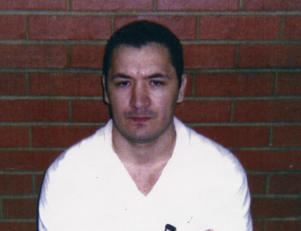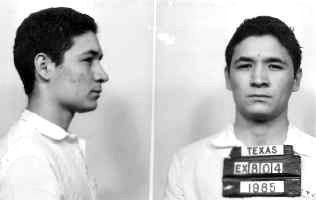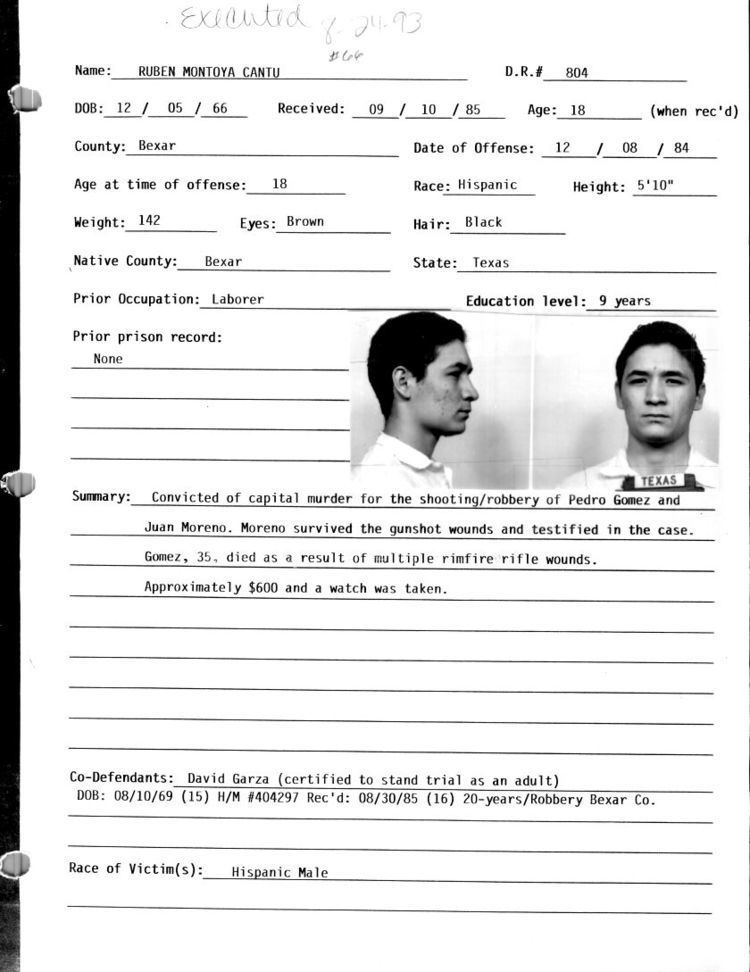Criminal status Deceased | Name Ruben Cantu | |
 | ||
Conviction(s) Murder and Attempt murder Died August 24, 1993, Huntsville, Texas, United States | ||
In loving memory of ruben cantu jr
Ruben Montoya Cantu (December 5, 1966 – August 24, 1993) was a Texan who was executed for murder committed when he was 17 years old. During the years following the conviction, the surviving victim, the co-defendant, the District Attorney, and the jury forewoman have all made public statements that cast doubt on Cantu's guilty verdict and death row.
Contents
- In loving memory of ruben cantu jr
- Background
- Convicted of armed robbery and murder
- Police revive investigation after Cantu shoots off duty officer
- Execution
- Recent developments
- References

Background

Ruben Cantu grew up with his mother and father, until the age of 14, when the couple split up, with Ruben's mother moving 20 miles (32 km) away, and Ruben and his father continuing to live in a trailer in a crime-ridden south San Antonio barrio. The neighborhood was home to a loose band of tough kids called the Grey Eagles, of which Cantu became a leader despite his being rather small and in special-ed classes at school. By age 15, he was stealing cars for an organized auto theft ring, often spending days at a time driving stolen cars to Mexico for cash. At a time when the San Antonio Police Department was embroiled in scandal, with vigilantes and drug-dealing officers well known to the community, Cantu was stealing cars and dodging the police. His older brothers had been arrested on drug and theft charges, but despite several run-ins with the police, Ruben was never convicted of anything before the November 1984 crime that led to his execution.
Convicted of armed robbery and murder

The prosecution's case at the trial that convicted Ruben Cantu is summarized as follows: On the night of November 8, 1984, at approximately 11:30 p.m., Ruben Cantu (age 17 at the time) and his friend David Garza (15), broke into a vacant San Antonio house under construction at 605 Briggs Street, and robbed two Hispanic males at gunpoint. The two victims, Pedro Gomez (25 or 35) and Juan Moreno (19), had been workmen sleeping on floor mattresses at a construction site, guarding against burglary, as a water heater had been recently stolen from the work site. The two victims were sleeping in their work clothes, with their pockets full of their cash earnings at the time of the robbery. Cantu and Garza were carrying a rifle, which they used to rob the two men of their wristwatches. As they tried to take their cash, they were interrupted by Gomez's attempt to retrieve a pistol hidden under his mattress. Gomez was shot at least nine times by the boys' rifle, dying instantly, and Moreno was also shot as many as nine times by the same rifle. Thinking they had killed both men, the two teens then fled the scene. Juan Moreno survived the attack, and was able to leave the house and call for help shortly after the event, though he lost one lung, one kidney, and part of his stomach.

Short on leads other than Moreno's description of two Latinos aged roughly 14 and 19, a neighborhood beat officer passed along a rumor from the halls of South San Antonio High School, where Cantu was in ninth grade. A shop teacher reported that three kids had been involved in the robbery and murder and that students were saying Cantu had done the killing. Questioned just before his arrest, Garza identified Cantu, saying he "saw Ruben come running out of the house" according to a detective's notes. The key trial witness, however, was Juan Moreno, the shooting survivor, who repeatedly identified Ruben Cantu in court.
A decade after Cantu was executed, Moreno recanted his story, as did Garza.
Police revive investigation after Cantu shoots off-duty officer
According to Juan Moreno, and consistent with police records, he was visited by police in the hospital the day after the shooting. But, due to the severity of his wounds, he was unable to speak and could barely move. Five days later, in a second interview, Moreno was shown a number of photos. Cantu's photo was not included and Moreno did not identify any of the people shown in the photos. On December 16, detectives visited Moreno a third time and showed him another array of five photos, including one of Ruben Cantu, who lived across the street from Moreno's job site where the crime occurred. He did not identify Ruben or anyone else from the photos shown to him during that police interview.
The case went cold, and no suspect was arrested. About four months after the robbery-murder, Cantu shot Joe De La Luz, an off-duty, plainclothes police officer, at the Scabaroo Lounge, a bar near Cantu's home. According to Cantu, the officer threatened him, revealing his concealed weapon, provoking Cantu (who was also armed) to fire at De La Luz whom he did not know was a police officer. According to De La Luz, he was shot four times by Cantu despite no provocation.
The case against Cantu for the barroom shooting had to be dropped, as police had illegally searched Cantu's home, rendering the case unprosecutable.
Officer De La Luz survived the shooting and a friend of his who worked homicide, Sgt. Bill Ewell, decided to immediately reopen the murder investigation against Ruben Cantu. On the following day, Sgt. Ewell sent an investigator to Juan Moreno a fourth time, this time showing Cantu's photo along with four others. Again, Juan Moreno did not identify Cantu as one of his attackers. But he did provide Cantu's name. One day later, a third homicide detective picked up Moreno (an undocumented immigrant from Mexico at the time), drove him to the police station, sat him down and showed him the same group of photos that included Cantu. On that third attempt, Moreno positively identified the photo of Cantu as being one of his attackers.
Years later Moreno said that the person who shot him had very curly hair and that he was never shown a photo of the real shooter.
David Garza, Cantu's codefendant, has since admitted involvement in the burglary, assault and murder. He says he did go inside the house with another boy, did participate in the robbery, and saw the murder take place, but that his accomplice was not Ruben Cantu. According to Garza, the real murderer was an elementary school friend of Cantu. This person, whose only criminal record is a single misdemeanor domestic assault conviction, denied that he had anything to do with the robbery and murder when he was interviewed by the Houston Chronicle in 2005.
Execution
Shortly after being convicted by a jury of first degree murder and sentenced, Cantu wrote a note to the people of San Antonio saying: "I have been framed in a capital murder case. I was framed because I shot an off-duty police officer named Joe De La Luz."
On August 24, 1993, at 22 minutes after midnight, at the age of 26, Cantu died by lethal injection, becoming the fifth juvenile offender to be executed by Texas. His final request was for a piece of bubble gum, which was denied. Asked if he had a last statement, he said, "No, sir."
Recent developments
Sam Millsap, who was the District Attorney presiding over the Cantu case, proclaimed himself a "lifelong supporter of the death penalty" in his commentary published in the San Antonio Express-News in the year 2000. In a December 2005 interview with the Express-News, Millsap expressed a newfound opposition to capital punishment. In that 2005 story, Millsap, an attorney in private practice at the time of the interview, says his decision to oppose the death penalty was affirmed, as evidence surfaced that Ruben Cantu was very likely innocent, when prosecuted by Millsap's office, and ultimately executed by the state of Texas. According to the 2005 Express-News story, "'It is troubling to me personally. No decision is more frightening than seeking the death penalty. We owe ourselves certainty on it.' He had that degree of certainty in the 1980s when he was the district attorney, 'when I was in my 30s and knew everything.' Now, he says, 'There is no way to have that kind of certainty.'" He went on to say that if Cantu was innocent, that means the person who committed the murder remains free and that "the misconduct by police officers could be addressed today."
Bexar County (San Antonio) District Attorney, Susan Reed, indicated to Rick Casey of the Houston Chronicle that she may bring a murder by perjury charge against Moreno, the surviving victim of the robbery-shooting and key prosecution witness. Juan Moreno is currently a building contractor living in east San Antonio with a teenage child of his own.
In 2006 Reed said that she was "deeply skeptical" of someone who recants testimony they gave twenty years previously but agreed that Cantu should not have been prosecuted as a death penalty case.
In 2007 Reed issued a report finding that Ruben Cantu was guilty of the crime for which Texas executed him in 1993; however, critics say the report is compromised by the fact Reed was the judge who rejected Cantu's appeal in 1988 and set his execution date in 1993. Reed assigned to the Cantu case two investigators, Mike Beers and James Moore, who were allegedly recorded ridiculing the case in a phone conversation and openly mocking the notion that Cantu might have been innocent.
